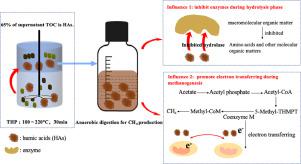Water Research ( IF 11.4 ) Pub Date : 2021-05-28 , DOI: 10.1016/j.watres.2021.117310 Fang Huang 1 , Hongbo Liu 2 , Jiaxin Wen 1 , Cheng Zhao 1 , Lu Dong 1 , He Liu 2

|
Humic-like acids (HAs) are abundant in sewage sludge but mainly bonded with solids. Thus, their influences are often neglected in conventional digestion processes. Currently thermal hydrolysis pretreatment (THP) has been widely adopted in sludge anaerobic digestion (AD) to enhance hydrolysis of complex matters and further to improve methane production. However, the impacts of enhanced release of HAs and the mechanisms involved are not well understood and need to be further investigated because the substantial amounts of HAs present in AD could severely threaten the sludge AD processes. Results in the present study indicated that the concentration of soluble HAs in sludge was elevated by 90 times due to the THP, from 8 mg/L in raw sludge to 727 mg/L in the pretreated sludge hydrolyzed at 180 °C. Moreover, the structural characteristics of soluble HAs, including aromatic condensation degree, elemental composition and functional group, also showed substantial differences with the increased temperature of the THP. Furthermore, the release of HAs presented significant influences on sludge digestion. Acidification rate was inhibited by over 50% with 0.4 g/L of HAs, whereas methanogenesis was improved by nearly 200% with 0.8 g/L HAs and inhibited about 50% with 2.0 g/L. The activities of proteinase and co-enzyme F420 were decreased by 20% and increased by 19%, respectively, under HAs stress at 0.6 g/L for 5 days. Moreover, molecular structural changes of soluble HAs also contributed to the influences. Especially, the E4/E6 value representing the degree of HAs aromatic condensation and C/N ratio of soluble HAs were closely correlated with their inhibition degree to sludge hydrolysis. The findings of this study demonstrate that the influences of HAs are evident and also vary to the different steps of anaerobic digestion processes, which shall not be negligible during the sludge digestion that is with THP. Due to the rate-limiting step was methanogenesis in the AD process of pretreated sludge by thermal hydrolysis, HAs concentration was recommended at low level, for example around 1.0 g/L, to accelerate or not limit methanogenesis.
中文翻译:

污泥热水解过程中腐殖酸释放量被低估及其对厌氧消化的影响
类腐殖酸 (HA) 在污水污泥中含量丰富,但主要与固体结合。因此,它们的影响在传统的消化过程中常常被忽视。目前,热水解预处理(THP)已被广泛用于污泥厌氧消化(AD),以增强复杂物质的水解,进一步提高甲烷产量。然而,增强释放 HA 的影响和所涉及的机制尚不清楚,需要进一步研究,因为 AD 中存在的大量 HA 可能严重威胁污泥 AD 过程。本研究的结果表明,由于 THP,污泥中可溶性 HA 的浓度提高了 90 倍,从原始污泥中的 8 mg/L 到 180 °C 水解的预处理污泥中的 727 mg/L。而且,可溶性 HAs 的结构特征,包括芳香族缩合度、元素组成和官能团,也随着 THP 温度的升高而出现显着差异。此外,HAs的释放对污泥消化有显着影响。使用 0.4 g/L HA 时,酸化率被抑制了 50% 以上,而使用 0.8 g/L HA 时产甲烷作用提高了近 200%,使用 2.0 g/L 时抑制了约 50%。蛋白酶和辅酶F的活性 而 0.8 g/L 的 HA 使产甲烷作用提高了近 200%,而 2.0 g/L 的产甲烷作用则抑制了约 50%。蛋白酶和辅酶F的活性 而 0.8 g/L 的 HA 使产甲烷作用提高了近 200%,而 2.0 g/L 的产甲烷作用则抑制了约 50%。蛋白酶和辅酶F的活性在 0.6 g/L 的 HA 胁迫下 5 天,420分别减少了 20% 和增加了 19%。此外,可溶性 HA 的分子结构变化也有助于影响。特别是代表HAs芳香缩合程度的E4/E6值和可溶性HAs的C/N比与其对污泥水解的抑制程度密切相关。本研究的结果表明,HAs 的影响是明显的,并且随着厌氧消化过程的不同步骤而变化,在使用 THP 的污泥消化过程中,HAs 的影响不容忽视。由于通过热水解预处理污泥的 AD 过程中的限速步骤是产甲烷,因此建议 HA 浓度较低,例如 1.0 g/L 左右,以加速或不限制产甲烷。











































 京公网安备 11010802027423号
京公网安备 11010802027423号